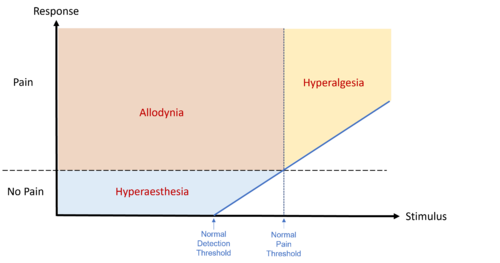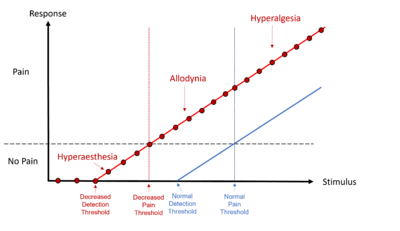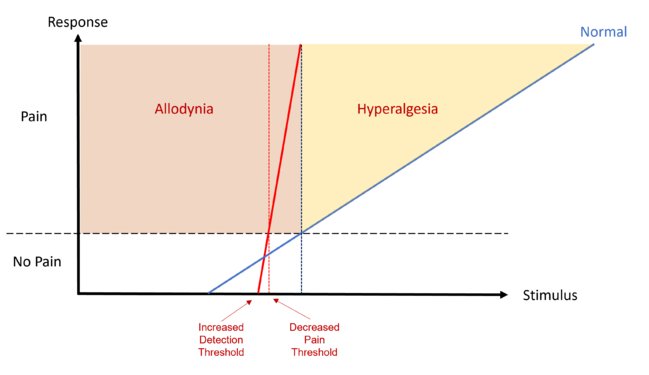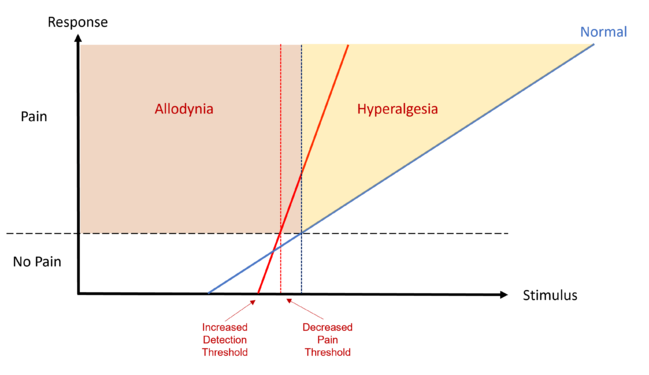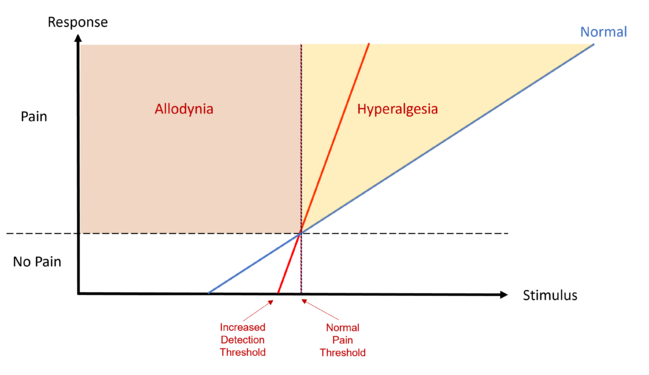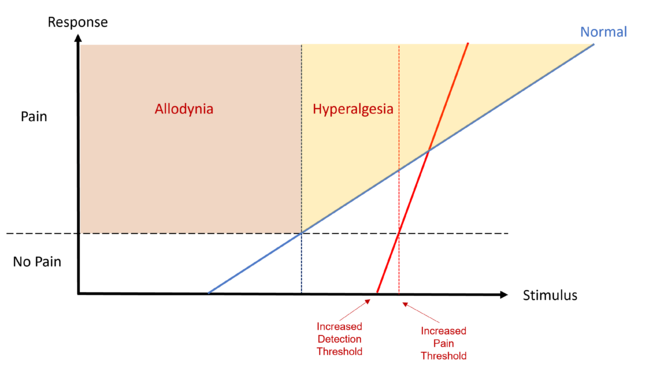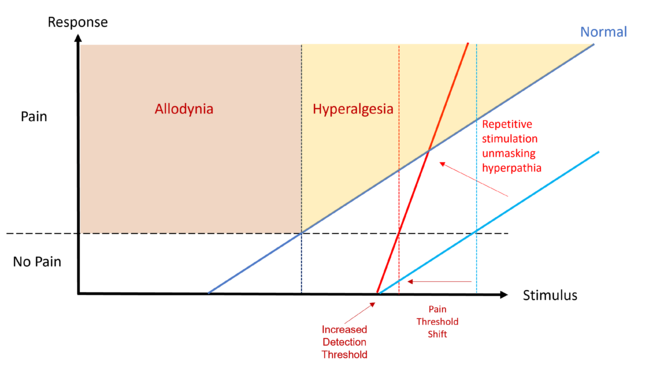Allodynia and Alloknesis: Difference between revisions
No edit summary |
No edit summary |
||
| (16 intermediate revisions by the same user not shown) | |||
| Line 1: | Line 1: | ||
Allodynia and alloknesis are abnormal sensory states where normally innocuous stimuli elicit unpleasant sensations or aversive behavioural responses. | {{Authors | ||
|Authors=Jeremy | |||
}} | |||
{{Article | |||
|quality=Complete | |||
|notice=Curriculum | |||
}} | |||
[[File:Hyperalgesia and allodynia.png|thumb|500x500px|Stimulus response curve showing allodynia, hyperalgesia, and hyperaesthesia. Any reduction in pain threshold is allodynia, while any increased pain to supra-threshold stimuli is hyperalgesia.]]Allodynia and alloknesis are abnormal sensory states where normally innocuous stimuli elicit unpleasant sensations or aversive behavioural responses. | |||
==Allodynia, Hyperalgesia, and Hyperpathia== | |||
[[File:Allodynia and hyperalgesia thresholds.png|thumb|400x400px|Stimulus response curve comparing detection and pain thresholds in different states.]] | |||
== Allodynia | ===Allodynia=== | ||
The IASP defines '''allodynia''' as "Pain due to a stimulus that does not normally provoke pain." It is a nociceptive sensation or aversive response elicited by a normally non-nociceptive stimulus. "allo" means other, and "dynia" means pain. | The IASP defines '''allodynia''' as "Pain due to a stimulus that does not normally provoke pain." It is a nociceptive sensation or aversive response elicited by a normally non-nociceptive stimulus. "allo" means other, and "dynia" means pain. It can occur with mechanical, thermal, or chemical stimuli (e.g. tactile allodynia, heat allodynia). | ||
Examples of normally non-painful sensations that may be painful in allodynia are pain from light stroking of the skin with the gliding of clothing, or pain from the intrinsic heat generated by the body. | Examples of normally non-painful sensations that may be painful in allodynia are pain from light stroking of the skin with the gliding of clothing, or pain from the intrinsic heat generated by the body. | ||
| Line 8: | Line 17: | ||
Clinical examples of allodynia are skin sensitivity following sunburn, tenderness of the skin during migraine, painful gut mobility with irritable bowel syndrome, painful muscles following tissue trauma or inflammation, skin sensitivity with various nervous system disorders. | Clinical examples of allodynia are skin sensitivity following sunburn, tenderness of the skin during migraine, painful gut mobility with irritable bowel syndrome, painful muscles following tissue trauma or inflammation, skin sensitivity with various nervous system disorders. | ||
===Hyperalgesia=== | |||
In contrast, '''hyperalgesia''' is defined by the IASP as "Increased pain from a stimulus that normally provokes pain." An example is the prick of a needle, which is normally painful, but with hyperalgesia there is a greater than normal magnitude and/or duration of pain. | In contrast, '''hyperalgesia''' is defined by the IASP as "Increased pain from a stimulus that normally provokes pain." An example is the prick of a needle, which is normally painful, but with hyperalgesia there is a greater than normal magnitude and/or duration of pain. | ||
| Line 14: | Line 24: | ||
The sensitised neurons in the spinothalamic tract produce either de novo activity or greater than normal response to both innocuous stimuli (allodynia) and noxious stimuli (hyperalgesia). | The sensitised neurons in the spinothalamic tract produce either de novo activity or greater than normal response to both innocuous stimuli (allodynia) and noxious stimuli (hyperalgesia). | ||
== Alloknesis and Hyperknesis == | ===Hyperpathia=== | ||
'''Hyperpathia''' is essentially a type of allodynia and hyperalgesia that describes a complex sensory experience. The IASP define hyperpathia as "a painful syndrome characterised by an abnormally painful reaction to a stimulus, as well as an increased threshold." | |||
Hyperpathia may occur alongside allodynia, hyperaesthesia, hyperalgesia, or dysaesthesia (dysaesthesia is an abnormal sensory experience, either unpleasant or evoked). Some view it has a type of hyperaesthesia, or even equate the two terms. There is both an elevation of the detection threshold and central hyperexcitability. It can occur in axonal loss and in central sensitisation states. | |||
There are four main features of hyperpathia.<ref name=":1">John Scadding. Hyperpathia. Encyclopedia of Pain 2013.</ref> | |||
#''Increased detection threshold'': An increased threshold to noxious or non-noxious stimulation. This may be due to reduced afferent input. | |||
#''Delay:'' An abnormal latent period in the perception of the stimulus. This may be due to reduced large fibre afferent input. | |||
#''Summation'': this refers to an increasingly painful sensation to a repetitive stimulus of steady intensity which unmasks hyperpathia. Summation can be seen as an explosive overshooting pain response that can occur with strong withdrawal movements and a vasomotor or vegetative reaction. There is a lack or insufficient relationship between the stimulus strength and sensation strength. There is poor localisation and the inability to identify the nature of the stimulus that elicited the pain, with a radiating sensation out from the point of sensation to wide adjacent areas. Summation may be due to afterdischarge in damaged sensory neurons, crossed afterdischarge in sensory neurons, coupling of adjacent nerves, and central sensitisation. | |||
#''Aftersensation'': there is a long aftersensation or pain after the stimulus has ceased. This can occur for seconds, minutes, or hours after only brief periods of stimulation. | |||
<gallery mode="packed" heights="250"> | |||
File:Hyperpathia increased DT decreased PT allodynia.png|Hyperpathia with increased DT, decreased PT, allodynia, and steeper stimulus-response curve as compared to normal | |||
File:Hyperpathia increased DT decreased PT hyperalgesia.png|Hyperpathia with increased DT, decreased PT, allodynia, hyperalgesia, and steeper stimulus-response curve as compared to normal. | |||
File:Hyperpathia increased DT normal PT hyperalgesia.png|Hyperpathia with increased DT, normal PT, hyperalgesia, and steeper stimulus-response curve as compared to normal. | |||
File:Hyperpathia increased DT increased PT hyperalgesia.png|Hyperpathia with increased DT, increased PT, hyperalgesia, and steeper stimulus-response curve as compared to normal. | |||
File:Hyperpathia unmasking.png|With repetitive stimulation, pain threshold decreases and the slope of the curve increases thereby unmasking hyperpathia | |||
</gallery> | |||
==Alloknesis and Hyperknesis== | |||
The IASP do not provide a definition for '''alloknesis'''. It is the itch or pruriceptive sensation or scratching behaviour that is elicited by a stimulus that is not normally pruriceptive. "allo" means other, and "knesis" means itch. In the normal state, light stroking of the skin may elicit a ticklish sensation, but not itch. Following a mosquito bite or in an area of dermatitis, light stroking can evoke itch or exacerbation of an already present itch. | The IASP do not provide a definition for '''alloknesis'''. It is the itch or pruriceptive sensation or scratching behaviour that is elicited by a stimulus that is not normally pruriceptive. "allo" means other, and "knesis" means itch. In the normal state, light stroking of the skin may elicit a ticklish sensation, but not itch. Following a mosquito bite or in an area of dermatitis, light stroking can evoke itch or exacerbation of an already present itch. | ||
| Line 27: | Line 55: | ||
It is thought that there are pruriceptive spinothalamic neurons that are sensitised to light mechanical touch and punctate stimulation. | It is thought that there are pruriceptive spinothalamic neurons that are sensitised to light mechanical touch and punctate stimulation. | ||
== Primary and Secondary == | ==Primary and Secondary== | ||
The above terms are also categorised as primary and secondary. Primary is changes in the area that was directly exposed to the stimulus. Secondary is when there is extension well beyond the area. An example is a first degree burn, which exhibits primary allodynia and hyperalgesia in the area of the burn, and secondary allodynia and hyperalgesia in the area surrounding the burn. | The above terms are also categorised as primary and secondary. Primary is changes in the area that was directly exposed to the stimulus. Secondary is when there is extension well beyond the area. An example is a first degree burn, which exhibits primary allodynia and hyperalgesia in the area of the burn, and secondary allodynia and hyperalgesia in the area surrounding the burn. | ||
== Pain and Itch Interactions == | ==Pain and Itch Interactions== | ||
There are connections between the pruriceptive and nociceptive neural systems. Itch is inhibited centrally by nociceptive mechanisms and hyperalgesia. Experimentally evoked itch occurs with selective activation of pruriceptive neurons in the absence of activity in non-pruriceptive nociceptive neurons. | There are connections between the pruriceptive and nociceptive neural systems. Itch is inhibited centrally by nociceptive mechanisms and hyperalgesia. Experimentally evoked itch occurs with selective activation of pruriceptive neurons in the absence of activity in non-pruriceptive nociceptive neurons. | ||
| Line 39: | Line 67: | ||
The reason why rubbing inhibits the sensation of itch is because this stimulates myelinated A fibre low threshold mechanoreceptors. Scratching also inhibits histamine evoked neural activity in pruriceptive spinothalamic neurons though the stimulation of nociceptors. | The reason why rubbing inhibits the sensation of itch is because this stimulates myelinated A fibre low threshold mechanoreceptors. Scratching also inhibits histamine evoked neural activity in pruriceptive spinothalamic neurons though the stimulation of nociceptors. | ||
== See Also == | ==See Also== | ||
*[https://www.iasp-pain.org/resources/terminology/ IASP Definitions] | *[https://www.iasp-pain.org/resources/terminology/ IASP Definitions] | ||
* [[Histamine]] | *[[Histamine]] and [[Antihistamines]] | ||
* [[Central Sensitisation]] | *[[Central Sensitisation]] | ||
* [[Nociception]] | *[[Nociception]] | ||
*[[Neuropathic Pain]] | |||
== References == | ==References== | ||
Robert LaMotte. Allodynia and Alloknesis. Encyclopedia of Pain 2013 | Robert LaMotte. Allodynia and Alloknesis. Encyclopedia of Pain 2013 | ||
[[Category: | [[Category:Physiology]] | ||
<references /> | |||
{{References}} | |||
{{Reliable sources | |||
|synonym1=allodynia | |||
|synonym2=hyperalgesia | |||
}} | |||
Latest revision as of 21:29, 17 April 2022
Allodynia and alloknesis are abnormal sensory states where normally innocuous stimuli elicit unpleasant sensations or aversive behavioural responses.
Allodynia, Hyperalgesia, and Hyperpathia
Allodynia
The IASP defines allodynia as "Pain due to a stimulus that does not normally provoke pain." It is a nociceptive sensation or aversive response elicited by a normally non-nociceptive stimulus. "allo" means other, and "dynia" means pain. It can occur with mechanical, thermal, or chemical stimuli (e.g. tactile allodynia, heat allodynia).
Examples of normally non-painful sensations that may be painful in allodynia are pain from light stroking of the skin with the gliding of clothing, or pain from the intrinsic heat generated by the body.
Clinical examples of allodynia are skin sensitivity following sunburn, tenderness of the skin during migraine, painful gut mobility with irritable bowel syndrome, painful muscles following tissue trauma or inflammation, skin sensitivity with various nervous system disorders.
Hyperalgesia
In contrast, hyperalgesia is defined by the IASP as "Increased pain from a stimulus that normally provokes pain." An example is the prick of a needle, which is normally painful, but with hyperalgesia there is a greater than normal magnitude and/or duration of pain.
Allodynia and hyperalgesia can be experimentally induced by injected capsaicin intradermally. Capsaicin is thought to activate a subpopulation of mechanically insensitive nociceptive afferent peripheral neurons. These neurons sensitise second order neurons in the dorsal horn. The second order neurons receive convergent input from both thickly myelinated low-threshold primary afferents that mediate touch sensation and thinly myelinated nociceptive afferents that mediate the sense of mechanical pricking pain.
The sensitised neurons in the spinothalamic tract produce either de novo activity or greater than normal response to both innocuous stimuli (allodynia) and noxious stimuli (hyperalgesia).
Hyperpathia
Hyperpathia is essentially a type of allodynia and hyperalgesia that describes a complex sensory experience. The IASP define hyperpathia as "a painful syndrome characterised by an abnormally painful reaction to a stimulus, as well as an increased threshold."
Hyperpathia may occur alongside allodynia, hyperaesthesia, hyperalgesia, or dysaesthesia (dysaesthesia is an abnormal sensory experience, either unpleasant or evoked). Some view it has a type of hyperaesthesia, or even equate the two terms. There is both an elevation of the detection threshold and central hyperexcitability. It can occur in axonal loss and in central sensitisation states.
There are four main features of hyperpathia.[1]
- Increased detection threshold: An increased threshold to noxious or non-noxious stimulation. This may be due to reduced afferent input.
- Delay: An abnormal latent period in the perception of the stimulus. This may be due to reduced large fibre afferent input.
- Summation: this refers to an increasingly painful sensation to a repetitive stimulus of steady intensity which unmasks hyperpathia. Summation can be seen as an explosive overshooting pain response that can occur with strong withdrawal movements and a vasomotor or vegetative reaction. There is a lack or insufficient relationship between the stimulus strength and sensation strength. There is poor localisation and the inability to identify the nature of the stimulus that elicited the pain, with a radiating sensation out from the point of sensation to wide adjacent areas. Summation may be due to afterdischarge in damaged sensory neurons, crossed afterdischarge in sensory neurons, coupling of adjacent nerves, and central sensitisation.
- Aftersensation: there is a long aftersensation or pain after the stimulus has ceased. This can occur for seconds, minutes, or hours after only brief periods of stimulation.
Alloknesis and Hyperknesis
The IASP do not provide a definition for alloknesis. It is the itch or pruriceptive sensation or scratching behaviour that is elicited by a stimulus that is not normally pruriceptive. "allo" means other, and "knesis" means itch. In the normal state, light stroking of the skin may elicit a ticklish sensation, but not itch. Following a mosquito bite or in an area of dermatitis, light stroking can evoke itch or exacerbation of an already present itch.
Hyperknesis on the other hand is increased pruriception from a stimulus that normally provokes pruritis. An example is a fine diameter hair, which normally elicits a slight prickle and itch sensation, is magnified in intensity and/or duration in the setting of hyperknesis.
Pruritis is seen in many medical conditions such as CKD, lymphoma, HIV, post-herpetic neuralgia, multiple sclerosis, cholestasis, atopic dermatitis, allergic dermatitis, and irritant dermatitis.
Allokinesis can be produced experimentally by injected histamine intradermally. Histamine causes a red space, flare, and wheal to form. The flare is caused by a local axon reflex with the release of vasodilatory neuropeptides from nerve terminals. Wheal formation is due to local oedema. Allokinesis is present within the wheal, and hyperkinesis develops in the surrounding skin, as well as punctate hyperalgesia.
However, flare and wheal reactions are not necessary for pruritis to occur. This is shown through the insertion of cowhide spicules into the skin, which cause pruritis, but not a wheal or flare.
It is thought that there are pruriceptive spinothalamic neurons that are sensitised to light mechanical touch and punctate stimulation.
Primary and Secondary
The above terms are also categorised as primary and secondary. Primary is changes in the area that was directly exposed to the stimulus. Secondary is when there is extension well beyond the area. An example is a first degree burn, which exhibits primary allodynia and hyperalgesia in the area of the burn, and secondary allodynia and hyperalgesia in the area surrounding the burn.
Pain and Itch Interactions
There are connections between the pruriceptive and nociceptive neural systems. Itch is inhibited centrally by nociceptive mechanisms and hyperalgesia. Experimentally evoked itch occurs with selective activation of pruriceptive neurons in the absence of activity in non-pruriceptive nociceptive neurons.
If an anaesthetised area of skin is injected with histamine, there is enhanced itch. There are potentially two classes of histamine-sensitive neurons: a pruritic class and antipruritic class. The antipruritic class evokes a centrally mediated reduction in histamine evoked itch. The anaesthetic may block the discharge of the antipruritic effects, thereby preventing central inhibition, and unmasking the pruritic afferent effects.[2]
In contrast, if skin is injected with capsaicin, there is absent or reduced histamine-induced itch.[3]
The reason why rubbing inhibits the sensation of itch is because this stimulates myelinated A fibre low threshold mechanoreceptors. Scratching also inhibits histamine evoked neural activity in pruriceptive spinothalamic neurons though the stimulation of nociceptors.
See Also
References
Robert LaMotte. Allodynia and Alloknesis. Encyclopedia of Pain 2013
- ↑ John Scadding. Hyperpathia. Encyclopedia of Pain 2013.
- ↑ Atanassoff PG, Brull SJ, Zhang J, Greenquist K, Silverman DG, Lamotte RH. Enhancement of experimental pruritus and mechanically evoked dysesthesiae with local anesthesia. Somatosens Mot Res. 1999;16(4):291-8. doi: 10.1080/08990229970357. PMID: 10632026.
- ↑ Brull SJ, Atanassoff PG, Silverman DG, Zhang J, Lamotte RH. Attenuation of experimental pruritus and mechanically evoked dysesthesiae in an area of cutaneous allodynia. Somatosens Mot Res. 1999;16(4):299-303. doi: 10.1080/08990229970366. PMID: 10632027.
Literature Review
- Reviews from the last 7 years: review articles, free review articles, systematic reviews, meta-analyses, NCBI Bookshelf
- Articles from all years: PubMed search, Google Scholar search.
- TRIP Database: clinical publications about evidence-based medicine.
- Other Wikis: Radiopaedia, Wikipedia Search, Wikipedia I Feel Lucky, Orthobullets,
